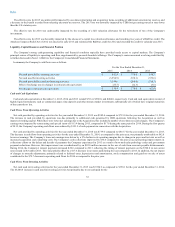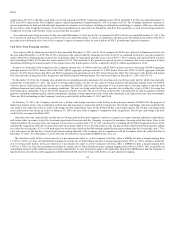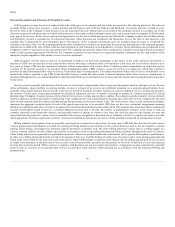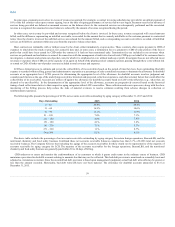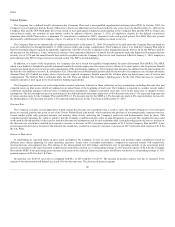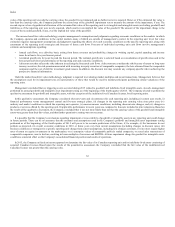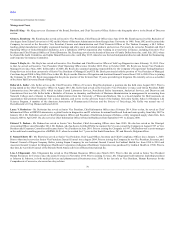LabCorp 2015 Annual Report Download - page 62
Download and view the complete annual report
Please find page 62 of the 2015 LabCorp annual report below. You can navigate through the pages in the report by either clicking on the pages listed below, or by using the keyword search tool below to find specific information within the annual report.
Index
value of the reporting unit exceeds the carrying value, the goodwill is not impaired and no further review is required. However, if the estimated fair value is
less than the carrying value, the Company performs the second step of the goodwill impairment test to measure the amount of the impairment, if any. The
second step involves a hypothetical allocation of the estimated fair value of the reporting unit to its tangible and intangible assets (excluding goodwill) and
liabilities as if the reporting unit were newly acquired, which results in an implied fair value of the goodwill. The amount of the impairment charge is the
excess of the recorded goodwill, if any, over the implied fair value of the goodwill.
The income-based fair value methodology requires management's assumptions and judgments regarding economic conditions in the markets in which
the Company operates and conditions in the capital markets, many of which are outside of management's control. At the reporting unit level, fair value
estimation requires management's assumptions and judgments regarding the effects of overall economic conditions on the specific reporting unit, along with
assessment of the reporting unit's strategies and forecasts of future cash flows. Forecasts of individual reporting unit cash flows involve management's
estimates and assumptions regarding:
• Annual cash flows, on a debt-free basis, arising from future revenues and profitability, changes in working capital, capital spending and income
taxes for at least a five-year forecast period.
• A terminal growth rate for years beyond the forecast period. The terminal growth rate is selected based on consideration of growth rates used in the
forecast period, historical performance of the reporting unit and economic conditions.
• A discount rate that reflects the risks inherent in realizing the forecasted cash flows. A discount rate considers the risk-free rate of return on long-term
treasury securities, the risk premium associated with investing in equity securities of comparable companies, the beta obtained from the comparable
companies and the cost of debt for investment grade issuers. In addition, the discount rate may consider any company-specific risk in achieving the
prospective financial information.
Under the market-based fair value methodology, judgment is required in evaluating market multiples and recent transactions. Management believes that
the assumptions used for its impairment tests are representative of those that would be used by market participants performing similar valuations of the
reporting units.
Management concluded that no triggering events occurred during 2015 related to goodwill and indefinite-lived intangible assets. As such, management
performed its annual goodwill and intangible asset impairment testing as of the beginning of the fourth quarter of 2015. The Company elected to perform the
qualitative assessment for goodwill and intangible assets, with the exception of the indefinite-lived Canadian licenses, for all reporting units.
In this qualitative assessment, the Company considered relevant events and circumstances for each reporting unit, including (i) current year results, ii)
financial performance versus management’s annual and five-year strategic plans, iii) changes in the reporting unit carrying value since prior year, (iv)
industry and market conditions in which the reporting unit operates, (v) macroeconomic conditions, including discount rate changes, and (vi) changes in
products or services offered by the reporting unit. If applicable, performance in recent years was compared to forecasts included in prior valuations. Based on
the results of the qualitative assessment, the Company concluded that it was not more likely than not that the carrying values of the goodwill and intangible
assets were greater than their fair values, and that further quantitative testing was not necessary.
It is possible that the Company's conclusions regarding impairment or recoverability of goodwill or intangible assets in any reporting unit could change
in future periods. There can be no assurance that the estimates and assumptions used in the Company's goodwill and intangible asset impairment testing
performed as of the beginning of the fourth quarter of 2015 will prove to be accurate predictions of the future, if, for example, (i) the businesses do not
perform as projected, (ii) overall economic conditions in 2016 or future years vary from current assumptions (including changes in discount rates), (iii)
business conditions or strategies for a specific reporting unit change from current assumptions, including loss of major customers, (iv) investors require higher
rates of return on equity investments in the marketplace or (v) enterprise values of comparable publicly traded companies, or actual sales transactions of
comparable companies, were to decline, resulting in lower multiples of revenues and EBITDA. A future impairment charge for goodwill or intangible assets
could have a material effect on the Company's consolidated financial position and results of operations.
In 2015, the Company utilized an income approach to determine the fair value of its Canadian reporting unit and its indefinite-lived assets consisting of
acquired Canadian licenses. Based upon the results of the quantitative assessment, the Company concluded that the fair value of the indefinite-lived
Canadian licenses was greater than the carrying value.
62



